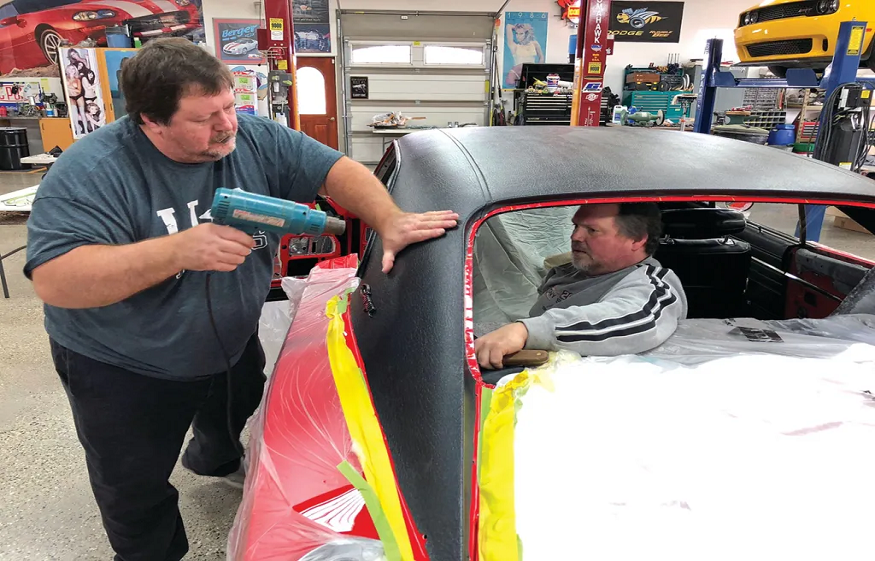Understanding Vinyl Top Replacement: A Guide for Vehicle Owners

When it comes to maintaining the appearance and functionality of your vehicle, certain aspects can often be overlooked until they start showing signs of wear. One such component is the vinyl top. A vinyl top replacement is not just about aesthetics but also plays a crucial role in protecting your vehicle from the elements. This article explores the importance of vinyl tops, the replacement process, and why it’s a worthwhile investment for your car or truck.
The Importance of Vinyl Tops
Vinyl tops, often found on classic cars, luxury vehicles, and some modern models, offer a protective layer that shields the roof from weather conditions, UV rays, and debris. Over time, exposure to sun, rain, and snow can cause wear and tear, leading to fading, cracking, or bubbling. In addition to this, the vinyl material itself may deteriorate due to age, resulting in an unsightly and potentially damaging roof.
Replacing a worn-out vinyl top can significantly enhance the look of your vehicle, making it appear newer and more polished. Beyond aesthetics, a vinyl top serves as an additional layer of protection for your car’s roof, preventing water from seeping into the interior and causing rust or mold. Furthermore, it acts as a barrier against direct sunlight, reducing the likelihood of damage to the car’s interior and upholstery.
The Vinyl Top Replacement Process
The process of vinyl top replacement can vary depending on the vehicle’s make and model, but there are a few key steps that are generally followed. First and foremost, the existing vinyl top needs to be carefully removed. This step requires precision to ensure the underlying roof structure is not damaged. The old vinyl is typically cut away and peeled off, leaving the metal roof exposed. Any adhesive residue or leftover material is also cleaned off to prepare the surface for the new vinyl.
Once the old vinyl top is removed, the next step is to inspect the condition of the roof. This is a critical moment, as any damage or rust underneath should be addressed before the new vinyl is applied. If there are any issues with the metal surface, they must be repaired to prevent further deterioration. Once the roof is cleaned, sanded, and prepped, a fresh layer of adhesive is applied to secure the new vinyl top in place.
The vinyl material is then carefully aligned and stretched over the roof, ensuring a smooth, wrinkle-free finish. The edges are trimmed neatly, and the vinyl is bonded to the roof using strong adhesives to ensure it stays in place. After the application, the new vinyl top is allowed to set and cure, ensuring that it’s securely adhered and will last for many years to come.
Choosing the Right Vinyl for Your Vehicle
Selecting the right type of vinyl for your replacement is just as important as the installation process. There are several factors to consider when choosing vinyl for your car’s top. First, the quality of the vinyl is crucial. High-quality vinyl will offer better durability, resistance to fading, and long-lasting performance, which is essential if you want your new vinyl top to stand the test of time.
Additionally, the color and texture of the vinyl should complement the overall design of your vehicle. For classic cars, maintaining the original style and appearance may be a priority, so choosing a vinyl that closely matches the original material is essential. On the other hand, if you’re replacing the vinyl top for aesthetic reasons, you may want to explore various colors and finishes that enhance the car’s exterior. Textured vinyl, for example, can add a unique, high-end appearance to the vehicle, while smooth vinyl provides a sleek, classic look.
The material’s resistance to environmental elements should also be considered. Vinyl that is UV-resistant, waterproof, and resistant to mildew will help protect your car from the damage that the elements can cause. Choosing a vinyl that offers both style and protection is the key to getting the most out of your investment.
Benefits of Vinyl Top Replacement
Replacing the vinyl top on your vehicle can have a profound impact, not just visually, but in terms of protection and longevity. A well-maintained vinyl top serves as a barrier against environmental damage. As mentioned earlier, exposure to UV rays can cause fading in the car’s paint job and upholstery. A vinyl top prevents these harmful effects, ensuring that your vehicle’s interior stays in better condition for a longer period.
Another benefit of a vinyl top replacement is the potential to increase the resale value of your vehicle. For collectors or individuals looking to sell their car, a fresh, well-installed vinyl top can make a significant difference in the car’s appeal. Buyers often prefer vehicles that appear well-maintained and are free from visible signs of aging, and a new vinyl top can be one of the most noticeable improvements to make.
Lastly, a vinyl top provides an extra layer of protection for the roof of your car. Without this layer, the metal roof is more susceptible to rust and corrosion, particularly if the vehicle is exposed to frequent rain or snow. A vinyl top acts as a protective shield, preventing moisture from reaching the metal surface and ensuring that the underlying roof stays intact.
Maintaining a Vinyl Top After Replacement
After your vinyl top replacement, regular maintenance is essential to ensure its longevity and appearance. Regular cleaning is a straightforward yet effective way to keep the vinyl in good condition. Using a soft cloth and a mild detergent, wipe down the surface to remove dirt, dust, and other debris. Harsh chemicals should be avoided, as they can damage the vinyl material over time.
In addition to cleaning, applying a vinyl protectant or conditioner can help maintain the material’s flexibility and prevent it from drying out or cracking. These products form a protective layer over the vinyl, offering additional UV protection and ensuring that the top retains its shine.
Finally, regular inspections are recommended to detect any signs of damage early. If you notice any peeling, bubbling, or cracking, it’s best to address the issue promptly. Small repairs can often prevent larger, more costly issues in the future, saving you time and money on a full replacement.






